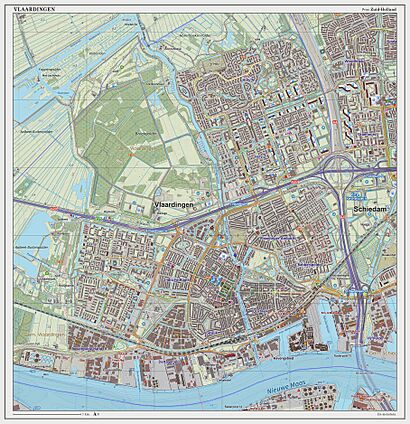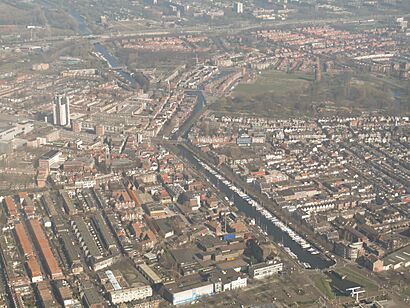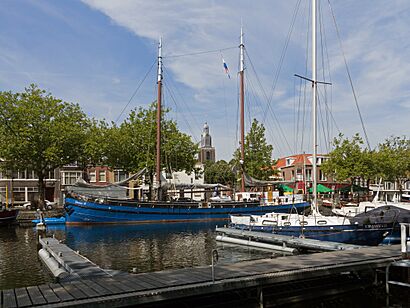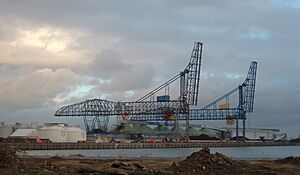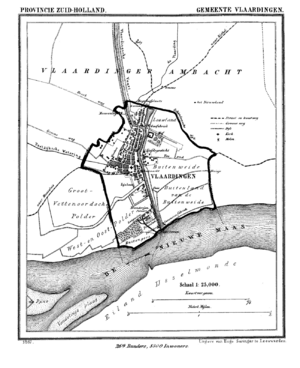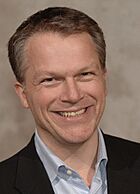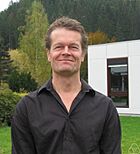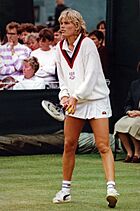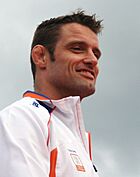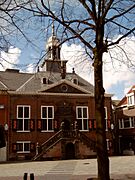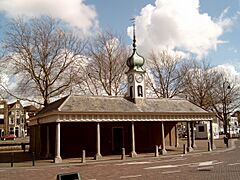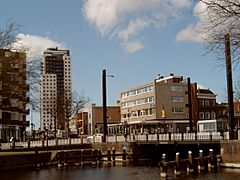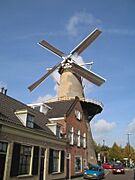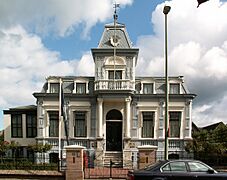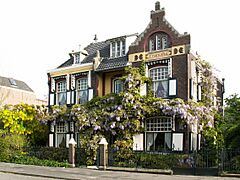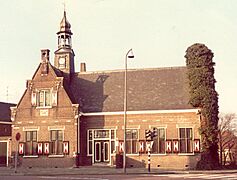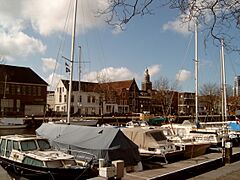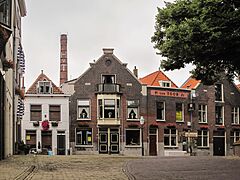Vlaardingen facts for kids
Quick facts for kids
Vlaardingen
|
|||
|---|---|---|---|
|
Town and municipality
|
|||
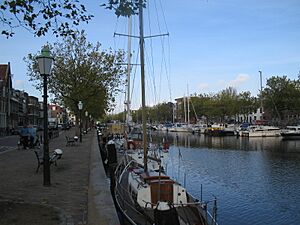
Old harbour in the centre of Vlaardingen
|
|||
|
|||
| Nickname(s):
Haringstad (Herring town)
|
|||
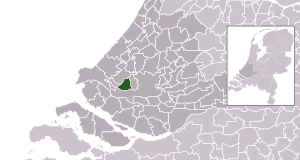
Location in South Holland
|
|||
| Country | Netherlands | ||
| Province | South Holland | ||
| Government | |||
| • Body | Municipal council | ||
| Area | |||
| • Total | 26.69 km2 (10.31 sq mi) | ||
| • Land | 23.64 km2 (9.13 sq mi) | ||
| • Water | 3.05 km2 (1.18 sq mi) | ||
| Elevation | 1 m (3 ft) | ||
| Population
(May 2014)
|
|||
| • Total | 71,338 | ||
| • Density | 3,018/km2 (7,820/sq mi) | ||
| Demonym(s) | Vlaardinger | ||
| Time zone | UTC+1 (CET) | ||
| • Summer (DST) | UTC+2 (CEST) | ||
| Postcode |
3130–3138
|
||
| Area code | 010 | ||
Vlaardingen is a big town and municipality in South Holland, a province in the Netherlands. It is located on the north side of the Nieuwe Maas river, where it meets the Oude Maas. The town covers an area of about 26.69 km2 (10.31 sq mi), with most of it being land. Around 71,338 people live here as of 2014.
Contents
Exploring Vlaardingen's Location
The town of Vlaardingen is split into two main parts. The A20 motorway divides the northern part (called "Holy") from the southern part. To the east, the A4 motorway separates Vlaardingen from the town of Schiedam.
Nearby Towns and Cities
Vlaardingen is surrounded by several other places. To the west, you'll find the small town of Maassluis. North of Vlaardingen are the village Schipluiden and the city of Delft. To the east are Schiedam and the big city of Rotterdam. Across the Nieuwe Maas river to the south-west is the town of Spijkenisse.
Road Connections
The A20 motorway connects Rotterdam to the village of Hook of Holland. There's also the Beneluxtunnel, a tunnel that goes under the Nieuwe Waterweg. This tunnel links the A20 to the A15.
Town Centre and Harbour
The very heart of Vlaardingen is on the west side of its old harbour. This harbour was originally a stream called 'De Vlaarding'. It flowed from the wet, spongy lands (peat lands) north and east of the town, all the way to the Meuse river.
Vlaardingen Through Time
People have lived in the area around Vlaardingen for a very long time, since about 2900 to 2600 BC (Before Christ). In 1990, scientists found a skeleton from around 1300 BC in Vlaardingen. They even found some human DNA from it, which was the oldest ever found in the Netherlands at that time!
Roman Times and Early Settlements
During Roman times, there might have been a small fort or village called Flenio where Vlaardingen is today. However, between about 250 AD (Anno Domini) and 700 AD, it seems like no one lived in this area, just like many other parts of the western Netherlands. The area is mentioned again in 726 or 727 as In Pagio Marsum. A small church was built there, and Vlaardingen grew up around it. This church is listed among those given to the Abbey of Echternach by Willibrord, a famous missionary.
Battles and Floods
In 1018, Vlaardingen was a strong base for Dirk III. He was charging an illegal fee (a toll) for ships passing on the Meuse river. The German Emperor Henry II sent an army to stop him, but Dirk III defeated them in the first Battle of Vlaardingen. Later, in 1047, his son Dirk IV also fought off another attack. These battles show how important Vlaardingen was back then.
A terrible flood on December 21, 1163, called the Saint Thomas Flood, stopped Vlaardingen from growing. The Counts of Holland moved away, and the town's progress slowed down.
Becoming a Town and the Eighty Years War
In 1273, Vlaardingen was officially given "town privileges" by Floris V, Count of Holland. This meant it had special rights, like holding markets. It's possible it had some rights even earlier, but we can't prove it.
During the Eighty Years War (a war where the Dutch fought for independence from Spain), in 1574, a group of Dutch fighters called Watergeuzen burned down Vlaardingen. This was ordered by William of Orange to stop the Spanish army from taking over the town.
Fishing and Industry
After the war, Vlaardingen became a place where ships were built. It also became a very important harbour for catching herring fish. The special fishing boats, first called "haringbuizen" and later "sloepen" and "loggers", stopped using Vlaardingen after World War II.
In 1855, a nearby municipality called Zouteveen joined with Vlaardingerambacht. Then, in 1941, during the German occupation of the Netherlands, Vlaardingerambacht also joined with Vlaardingen.
In the 1970s, Vlaardingen faced a big problem: air pollution. Because of many factories nearby, the town sometimes had unhealthy smog. One time, a high school even had to close because of it. This led to many environmental groups starting up in the area, as Vlaardingen was seen as one of the most polluted cities in the country.
Vlaardingen's Neighbourhoods
Vlaardingen is made up of eight main areas or neighbourhoods:
- Vlaardingen Centrum (the centre)
- Westwijk
- Vettenoordse polder (which includes industrial areas)
- Vlaardingen Oost (East Vlaardingen)
- Ambacht/Babberspolder
- Holy Zuid (South Holy)
- Holy Noord (North Holy)
- Broekpolder
Vlaardingen's Economy
A big research centre for Unilever is located in Vlaardingen. It's next to where the old Sunlight factory used to be. There are still some businesses in Eastern Vlaardingen that repair ships, located by the Nieuwe Maas River. The Vulcaanhaven (Vulcan Harbour) was once the largest privately owned artificial harbour in the world for many years.
The last major factory that processed herring, Warmelo & Van Der Drift, moved out of Vlaardingen in 2012. It went to Katwijk aan Zee. However, Vlaardingen still has ferry terminals. DFDS Seaways has ferries sailing to Felixstowe and Immingham in the UK, and P&O Ferries sails to Hull.
Things to See and Do in Vlaardingen
Vlaardingen has many interesting places to visit, especially historical buildings and a lively harbour.
Historical Buildings and Monuments
Some of the old buildings in town include the Grote Kerk (Big Church). This church was likely built between 1156 and 1164, and it has been changed, damaged, and rebuilt many times since then. Next to the church is the Waag (Weighing Bridge), and the old town hall, which is now used for weddings. All these are on the Markt, which used to be the main marketplace.
At the harbour, you can see the Visbank (Fish Auction) and the Oude Lijnbaan (Old Ropewalk), where ropes were made long ago. North of the old harbour is the old Aeolus windmill. This windmill still works and grinds grains!
The harbour itself is now a marina where boats are kept. It's also like an open-air museum with old ships. Right at the harbour, you'll find the Museum Vlaardingen. This museum teaches you all about commercial sea fishing and the history of Vlaardingen.
There's also a special memorial in Wijkpark Holy-Noord. It honours the crew of a Wellington bomber plane from No. 142 Squadron RAF. They died when their plane was shot down over Vlaardingen in March 1942. The memorial was put up in June 2012.
At Emaus Cemetery in Vlaardinger Ambacht, six members of a resistance group called "Geuzen" are buried. They were executed in March 1941 during World War II. Nine other tombstones nearby are there to remember nine more "Geuzen" members who were also executed and buried somewhere else.
Fun Events in Vlaardingen
The "Vlaardings Loggerfestival" is a popular event. A Logger is a type of traditional ship used for herring fishing. This festival happens on the first Saturday of June. It used to be called "Haring en Bierfeest" (Herring and Beer Festival). In 2003, the mayor changed the name, but in 2015, the original name "Haring en Bierfeest" came back!
Since 1987, a special award called the Geuzenpenning is given out every year. A local group, working with the town, gives this award to people from all over the world who work hard to protect human rights.
Famous People from Vlaardingen
Many interesting people were born in or have lived in Vlaardingen.
Counts of Holland
- Floris I, Count of Holland (around 1017–1061) was a Count of Holland (then called Frisia) from 1049 to 1061.
- Dirk IV, Count of Holland (around 1025–1049) was a Count of Holland from 1039 to 1049.
- Dirk V, Count of Holland (1052–1091) was a Count of Holland from 1061 to 1091.
- Floris II, Count of Holland (around 1085–1121) was a Count of Holland from 1091 to 1121.
Public Service and Politics
- Gerard Callenburgh (1642–1722) was a Dutch admiral and also a town councillor and mayor.
- Koos Vorrink (1891–1955) was a Dutch politician.
- Catharina Halkes (1920–2011) was a Dutch theologian and a feminist.
- Geert Mak (born 1946) is a Dutch journalist and writer of non-fiction books about history.
- Agnes van Ardenne (born 1950) is a retired Dutch politician and diplomat.
- Wouter Bos (born 1963) is a retired Dutch politician who was the Deputy Prime Minister from 2007 to 2010.
- Kees van der Staaij (born 1968) is a Dutch politician.
- Arjan El Fassed (born 1973) is a former Dutch politician, human rights activist, and aid worker.
Arts and Entertainment
- Dolf van der Linden (1915–1999) was a Dutch conductor of popular music.
- Bassie en Adriaan (brothers, born 1935 & 1942) are actors famous for their own children's TV show.
- Gerrit Berveling (born 1944) is a Dutch author who writes in Esperanto.
- Threes Anna (born 1959) is a novelist, theatre director, and film maker.
- Hans Neleman (born 1960) is an international photographer and film director.
- Karen Mulder (born 1970) is a Dutch model, singer, and former supermodel.
- Rik van de Westelaken (born 1971) is a Dutch TV presenter.
- Rajacenna van Dam (born 1994) is a Dutch artist known for her very realistic pencil drawings.
Science and Business
- Ericus Verkade (1835–1907) was a Dutch businessman who started the Verkade manufacturing company.
- Hans Bos (born 1950) is a Dutch biochemist and cancer researcher.
- Aart de Geus (born 1954) is a co-founder and CEO of Synopsys, a big technology company.
- Roel Pieper (born 1956) is a Dutch IT-entrepreneur.
- Aad van der Vaart (born 1959) is a Dutch professor of stochastics (the study of random processes) at Leiden University.
- Menno Schilthuizen (born 1965) is a Dutch evolutionary biologist and researcher.
- Jim Stolze (born 1973) is a tech-entrepreneur known for his work with TEDx.
Sports Stars
- Andries Hoogerwerf (1906–1977) was a middle-distance runner in the 1928 Summer Olympics.
- Rudie Liebrechts (born 1941) is a Dutch former speed skater and racing cyclist.
- Paul-Jan Bakker (born 1957) is a former Dutch cricketer.
- Juliette Bergmann (born 1958) is a Dutch female bodybuilding champion.
- Wim Koevermans (born 1960) is a former football player.
- Harald Wapenaar (born 1970) is a Dutch former football goalkeeper.
- Caroline Vis (born 1970) is a retired professional tennis player.
- Frank Kooiman (born 1970) is a retired Dutch football goalkeeper.
- Wilma van Hofwegen (born 1971) is a former freestyle swimmer who won a silver medal at the 2000 Summer Olympics.
- Serge Zwikker (born 1973) is a Dutch-American former basketball player.
- Mark Huizinga (born 1973) is a Dutch judoka champion who won a gold medal at the 2000 Summer Olympics and bronze medals in 1996 and 2004.
- Daniëlle de Bruijn (born 1978) is a water polo player who won a team gold medal at the 2008 Summer Olympics.
- Edith Bosch (born 1980) is a Dutch judoka who won a silver medal at the 2004 Summer Olympics and bronze medals in 2008 and 2012.
- Chantal Achterberg (born 1985) is a Dutch rower who won a team bronze medal at the 2012 Summer Olympics and a team silver medal in 2016.
- Carlo van Dam (born 1986) is a Dutch racing driver.
- Junior Strous (born 1986) is a Dutch racing driver.
- Ian Maatsen (born 2002) is a Dutch football player who plays for Borussia Dortmund.
Sister City
Vlaardingen has a special connection with another town:
|
Gallery
-
Villa "Francina", an Art Nouveau mansion from 1899
See also
 In Spanish: Vlaardingen para niños
In Spanish: Vlaardingen para niños




